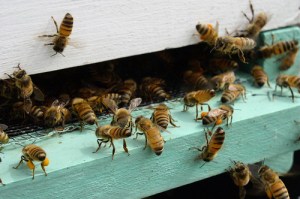
Photo by Rebecca Reardon.
It’s been three weeks since beekeepers filed a petition with the Environmental Protection Agency (EPA) to remove clothianidin — the pesticide widely suspected to be wreaking havoc on honeybee populations — from the market. In that time three studies have been released that strengthen the link between bee die-offs and neonicotinoids (neonics), the chemical family of which clothianidin is a member. Here’s what they found:
Study No. 1: Bees exposed to pesticides are getting lost.
French researchers found that honeybees exposed to the neonic pesticide thiamethoxam had trouble finding their way back to their hives — no small problem for a foraging species. The researchers used computer models to conclude that the disorienting effect of chemical exposure could, under some conditions, cause a hive’s population to decline by at least two-thirds.
Study No. 2: Bee colonies exposed to pesticides are smaller and the ratio of males to females is way off.
In another study published the same day in the journal Science, British researchers discovered that colonies exposed to another neonic, imidacloprid, suffered reduced growth rates and produced 85 percent fewer new queens.
Study No. 3: The more pesticides bees are exposed to, the faster they die.
Last week, Harvard scientists released [PDF] more damning news about imidacloprid: 15 of 16 hives exposed to it in a study they conducted died. The hives treated with the highest levels of the chemical perished first. The study’s authors are trumpeting it as the most convincing evidence so far of a direct link between neonics and colony collapse disorder. Not surprisingly, Bayer CropScience, the primary manufacturer of most commonly used neonics, called the study “seriously flawed.” Other scientists expressed some skepticism about it, but didn’t dismiss it by any means.
“I’m not sure [the Harvard study] makes the case for colony collapse disorder as strongly as the authors tried to make it,” said Jim Frazier, an entomologist at Penn State University. (He said the dying colonies observed in the study didn’t look identical to the collapsing colonies beekeepers have observed; the Harvard researchers said the characteristics were consistent.) But, Frazier said, “it does strengthen the case for neonicotinoids being toxic to bees.”
Imidacloprid was one of the first neonics to be used, back in the 1990s; though very similar in chemical structure to clothianidin, it’s actually less toxic — meaning it’s a good bet that whatever effects imidacloprid has on bees, clothianidin’s would be similar, and possibly worse. All neonics work in the same basic way: Seeds are treated with the chemicals prior to being sown, so the pesticide is expressed through the plants’ vascular systems, including in their nectar, where it can harm bees and other pollinators who come to forage.
Bonus irony: High fructose corn syrup is bad for bees too.
The Harvard study also shed light on another potential additional exposure route for bees to neonics: high fructose corn syrup. (As if we didn’t have enough problems with the stuff already!) Beekeepers sometimes feed it to their colonies when the insects need a supplemental sugar source to get through lean times of the year. But because it’s made from conventionally grown corn — duh — and virtually all of the corn in this country is treated with neonics, the Harvard researchers hypothesized that high fructose corn syrup could be poisoning bees with pesticides, too.
Let’s get this straight. Commercial beekeepers feed their colonies high fructose corn syrup to keep them alive so they can pollinate our crops. But that high fructose corn syrup could actually be sickening bees, because it’s tainted with the same pesticide that sickens them if they survive the corn syrup to get to the point of actually trying to do their job as pollinators. The agrochemical industry has basically turned bees’ life work into a kamikaze mission. It’s a wonder there are any of them left at all.
Frazier said the corn syrup angle hasn’t been discussed much before this study, and that although beekeepers don’t use it as often as they used to, it’s still “one of the most unique aspects” of the Harvard research. “One of the reasons [neonics have] become so widely used is because of their low toxicity to humans,” Frazier said. “It’s not surprising that there would be an allowable limit [of chemicals] in a food source like corn syrup that would not be significant for us, but would be potentially significant for bees.”
Even if the scientific jury’s still out on whether the Harvard study offers enough proof of a direct link between neonics and colony collapse disorder, the British and French studies published in Science continue to build the already strong case that these pesticides are, if not deadly to bees, then debilitating enough to be removed from the market, so they won’t cause any more harm to pollinators — a crucial link in our food chain.
“Those sublethal effects are far more extensive than anyone would have thought possible,” Frazier said.
Beekeepers and environmental groups couldn’t have asked for a better follow-up to their petition than the immediate release of three studies in a row piling on the evidence of neonics’ danger to bees. But don’t get too confident that the latest research will clinch their case: EPA doesn’t exactly have the best track record of responding to science when it comes to the relationship between bees and pesticides. Which leaves us to ask: How many studies will it take to drown out Bayer’s influence?
Take action: Sign Pesticide Action Network’s petition to Congress.



